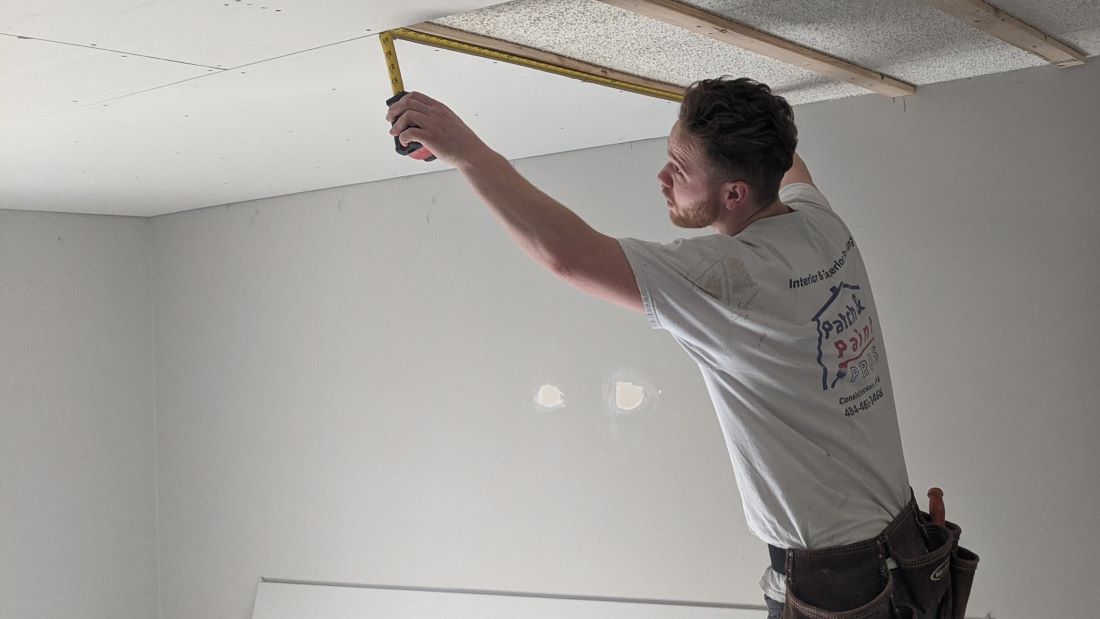
Are you noticing an unwelcome hole appearing in your ceiling? Don’t worry – it’s not the end of the world! Ceiling repairs are a relatively simple and painless process, so you can have your home looking back to its pre-damaged glory quickly and easily.
In this blog post, we’ll be taking you through everything you need to know about repairing holes in ceilings; how to identify the right type of repair material for the job, what tools are needed to get started, and most importantly, how to make sure that the area around the hole is properly secured before attempting any repairs. So whether it’s an unsightly cobweb crack or a larger more challenging problem at hand, read on if you’re ready to tackle repairing a hole in your ceiling with confidence!
What is the Quick and Easy Solution for a Hole in the Ceiling?
Holes in the ceiling are common occurrences, but they can be annoying and difficult to fix. Fortunately, there is a quick and easy solution to repair a hole in the ceiling. This method is considered to be cheap and effective, while not requiring a lot of time or effort.
Supplies Necessary to Hole Repair
The task of repairing a hole in the ceiling might seem daunting, but it doesn’t need to be. With the right supplies, this project can easily be completed in one weekend. Most households will already have most of the essential tools, like a hammer, screwdriver, drill, and sandpaper. As for drywall repair products, a drywall repair patch and drywall screws are usually readily available at home improvement stores nearby. With these supplies on hand and a bit of attention to detail, you’ll be able to tackle that pesky ceiling repair job with confidence.
How Does the Process Begin?
Once the area is cleared, sanded, and ready to go, it’s time to begin the ceiling repair. Depending on the ceiling texture, this could involve patching with a ceiling texture or a popcorn ceiling replacement. When dealing with gypsum plaster ceiling repair, for example, you may need to add two coats of portland cement-based patching compound – one thin layer and a thicker layer – to blend in with the existing ceiling texture.
After this is complete, you fill in any gaps or deep areas with spackling paste and let it dry before sanding it down and removing any debris and dust. After cleaning again, you can now apply freshly mixed joint compound or even a pre-mixed variety that matches your ceiling’s existing color or texture. This procedure completes the ceiling repair process and leaves you with a structurally sound ceiling surface that looks flawless.
Best Way to Repair a Hole in the Ceiling
The best way to repair a hole in the ceiling is to first install a self-adhesive patch. These patches are designed to be easy to install and provide a secure and stable bond to the ceiling. Additionally, these patches are also highly durable and can help to prevent future holes in the area. After the patch is in place, a putty knife can be used to fill in any gaps or cracks that may remain. The putty will provide an additional layer of protection between the ceiling and the patch.
How Can You Ensure a Professional Finish?
Getting the job done right requires the use of professional-grade materials, especially when faced with damage like water damage. When it comes to patching holes, applying a high-quality primer is key in providing a cost-efficient solution that won’t require immediate retouching after just a few months. The primer should be followed by a base coat and lastly, a topcoat will protect your patch and make sure it lasts for many years. With the right materials and methods, you can ensure water damage and other similar issues no longer affect your life.
Alternative Methods
While the self-adhesive patch is the most common and efficient way to repair a hole in the ceiling, some alternative methods may be considered. One option is to use an epoxy patch, which is designed to be easy to apply and provide a strong bond to the ceiling. Another alternative is to use a specialized filler, which is better for larger holes and requires a bit more time for application.
How Can You Ensure the Repair is Durable?
The repair should last for a long time, but it is important to take the proper steps to ensure that it is as durable as possible. After the patch and putty have been applied, the area should be reinforced by using a strong adhesive. This will help to prevent any further movement of the ceiling material and keep the patch firmly in place.
Benefits of Repairing a Hole in the Ceiling
Repairing a hole in the ceiling can offer numerous benefits for homeowners. When popcorn ceilings are involved, it is possible to blend the patched area with sanding and blending techniques that make it almost impossible to spot where the repair was made. If a regular drywall patch is needed, it shouldn’t take too much time or effort to complete, and the cost of repair will typically be lower than replacing the entire ceiling.
Plus, repairing any damage as soon as possible can help to prevent further damage in the future; water damage could occur if left unattended and termites can even find their way through tiny holes if not filled quickly enough. So make sure to act fast when it comes to those pesky ceiling holes!
What Should Be Done to Prevent Further Damage?
Once the hole in the ceiling is repaired, it is important to take further steps to prevent any further damage. For example, any possible sources of moisture should be identified and sealed, as moisture can lead to mold and mildew growth. Additionally, any visible signs of water damage in the surrounding area should be addressed as soon as possible to avoid any additional damage from occurring.
How Often Should the Repair be Checked?
Regular checking and maintenance of drywall ceiling repairs are important in helping to preserve the integrity of the drywall joint compound. Inspecting the repaired drywall at least once a year ensures that it is still in working condition, while any changes to the structure of the drywall should be immediately noted, as they can affect how well the drywall repair holds up over time and prevent further damage. This simple preventative action will save homeowners money on costly drywall repairs in the future.
Is it Possible to Perform the Repair Yourself?
Repairing drywall after an accident, like a ceiling hole created by a missing basketball, can be both satisfying and daunting. Depending on the size and complexity of the repair, it may be difficult yet still possible to perform oneself. However, if the repair is large or complex, it is highly recommended to seek professional help. Not only will this ensure that the size and shape of your wall are restored correctly, but will save valuable time and resources trying to make repairs yourself. In either case, it’s important to act fast as repairing drywall is an essential part of home maintenance that shouldn’t be overlooked.
Final Thoughts
Repairing a hole in the ceiling can provide numerous benefits, from improved aesthetics to preventing larger issues from occurring. By taking the proper steps and using the right materials, the repair should last for a long time and provide a secure and stable bond to the ceiling.
The repair process is relatively straightforward, but it is important to take the time to prepare the area and gather the necessary supplies. After the patch and putty have been applied, reinforced with an adhesive, and painted, the hole in the ceiling should now be fixed.
Overall, the quick and easy solution for a hole in the ceiling is a viable option. By following the steps outlined above, you can easily repair a hole in the ceiling and provide a quality finish that will last for many years.











